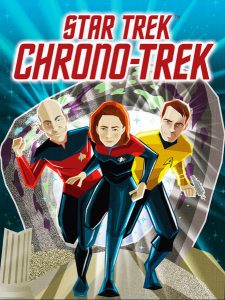 There are some themes I’m always down for. Cthulhu, post-apocalyptic, and the age of sail to name a few. But also pretty high on the list is time travel. Perhaps it’s my love of the Back to the Future movies or just the idea of messing with the time stream in general, but I’m always on the lookout for a new game that can bring that experience to my tabletop.
There are some themes I’m always down for. Cthulhu, post-apocalyptic, and the age of sail to name a few. But also pretty high on the list is time travel. Perhaps it’s my love of the Back to the Future movies or just the idea of messing with the time stream in general, but I’m always on the lookout for a new game that can bring that experience to my tabletop.
Many years ago I reviewed a quirky card game called Chrononauts. Published by filler game kingpin Looney Labs (Fluxx, Time Breaker), this game explored what would happen if travelers started monkeying with the time stream.
Today, Looney Labs have taken Chrononauts to the next level by dropping it into the Star Trek universe. Star Trek: Chrono-Trek puts players in the shoes of familiar Star Trek characters as they try and manipulate the time stream to their own ends.
Gameplay Overview:
Much like the original Chrononauts, Star Trek: Chrono-Trek is easy to play. A time stream of 32 cards are laid out in a grid and each player draws a hidden identity card. This ID card is a character from the Star Trek universe that has 3 goals for you to try and accomplish (more on that later).
On a player’s turn, they draw a card and then may play a card (or draw 2 cards if they don’t want to play a card).
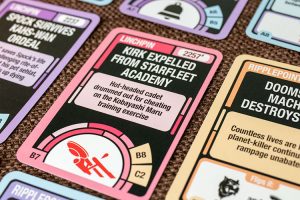
There are a variety of cards such as Artifacts, Events, Actions, Assignments, and Inverters. It’s these Inverter cards that will let players manipulate the timeline. When an Inverter is played, a chosen a linchpin card is flipped over. These are usually key points in the Star Trek timeline, such as Kirk cheating in the Kobayashi Maru or Voyager getting stranded.
When a linchpin is flipped, it will also flip one or more ripple points down the timeline For example, if Sisko never took the job on DS9, he and Dax would never have discovered the wormhole.
New to Star Trek: Chrono-Trek are anchor points. These are not flipped by players, but by events drawn from the deck. These represent the Devron Anomaly from Next Generation fame. The anomaly grows in size as it goes back in the timeline and if all five get flipped, all players lose.
Finally players have to be aware of Fractures. These work like Patches in the original game, yet represent alternate timelines. When one is played to the timeline, nothing after it can count for a win condition.
Turns go by in this manner until one player wins by matching the requirements noted on their ID card. Usually at least one artifact in play and some timeline adjustments (Most IDs have 3 requirements).
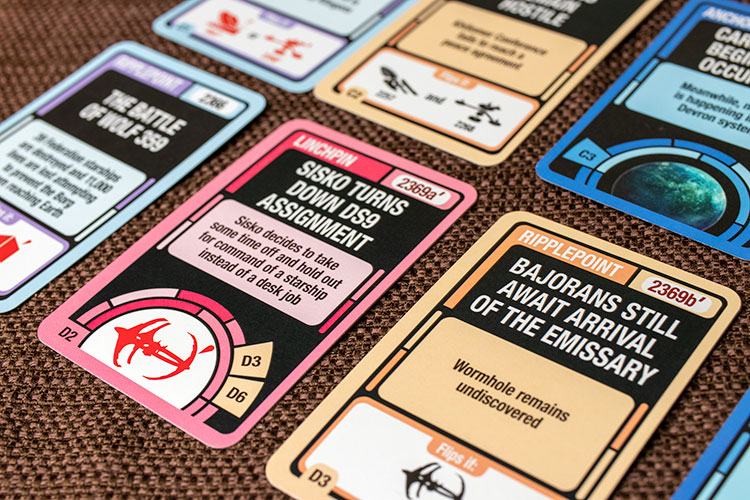
Game Experience:
Chrononauts was always a fairly random game and for those wondering, Looney Labs didn’t take that away in the years since. Star Trek: Chrono-Trek embraces everything crazy about the original, but does a great job of drawing from the source material to make this much more than just a pasted on theme.
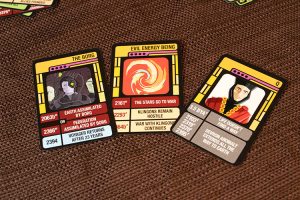
Game designer Andrew Looney did a great job of pulling important moments from Star Trek lore and bringing them to the game. I’ve always been a huge fan of alternate history, so I got a lot of enjoyment in seeing what would happen in different Star Trek timelines. Curious on how things would have played out if the tribble homeward was never annihilated or if the Enterprise-C was never destroyed? Now you can find out how things would have changed.
The ID cards come in four different levels in Star Trek: Chrono-Trek. They can also affect the length of the game quite a bit. I’ve found that the 1-2 pip cards can make for a shorter game and will most likely appeal to fans of the Fluxx series. The game more random and can end really unusually quickly. The level 3-4 ones will definitely draw out the game as their requirements are much steeper (especially the level four ones). One of the more unique IDs is Q, who simply wants the Devron Anomaly to destroy the universe.
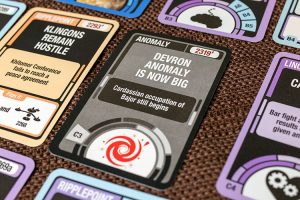
Even though Star Trek: Chrono-Trek offers some nice quality of life upgrades over the original Chrononauts, I think this one is primarily going to appeal to Trekkies. Part of the charm of this series has always been enjoying the alternate history and if you don’t know anything about the Star Trek universe, the game will lose a lot of its charm. Yet if you have been breathing Picard, Kirk, and Janeway for years, then you can get a lot of mileage out of this one. This thematic text creates some excellent “what if” scenarios and really draws players in. This is what I was missing from their earlier game, Time Breaker.
Finally, I should note that Star Trek: Chrono-Trek has a decent amount of “take that”. From stealing player’s artifacts, to action cards that let you cancel an action, no win is ever 100% safe. I also thought that the new fracture cards were a nice touch. The way they effect the timeline was really interesting, as they basically erase everything after them, which can really screw with people’s win conditions.
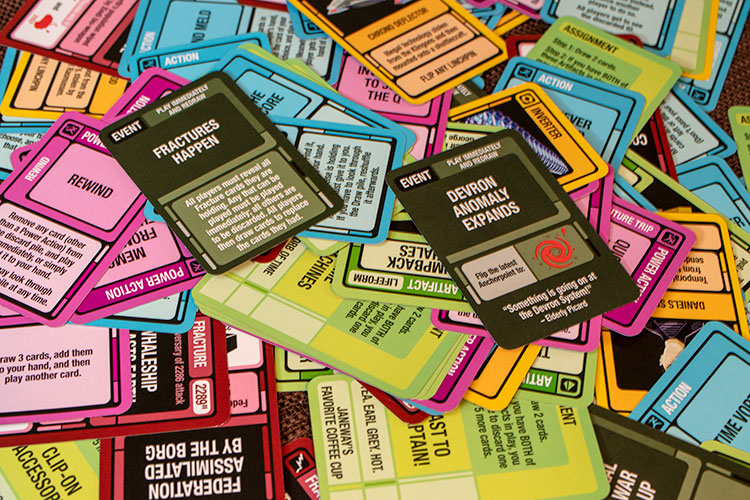
Final Thoughts:
Most gamers know that any Looney Labs game is going to come with a healthy dose of randomness, and Star Trek: Chrono-Trek doesn’t break from that mold. Games can last from 10-45 minutes, and it’s not impossible for someone to win in round 2 if you are plying with the 1 pip IDs. But included in all that randomness is a thematic game that really feels right at home in the Star Trek universe.
If you’ve never really been into Star Trek lore, then you will probably be better served with the original Chrononauts (although I’d love to see that one refreshed with the mechanics from this game). However, if you’re a Trekkie who loves thinking about “what if” scenarios, there is a good chance that you will have a lot of fun with Star Trek: Chrono-Trek.
Final Score: 3.5 stars – A game that lets players explore the Star Trek universe in many different ways, as long as you can handle the randomness.
 Hits:
Hits:
• Excellent use of the Star Trek theme
• Different ID levels can control the game length
• Enjoyed the new event/anomaly cards
Misses:
• Low pip IDs feel almost too easy
• Loses a lot of its appeal for non-Trekkies.






















